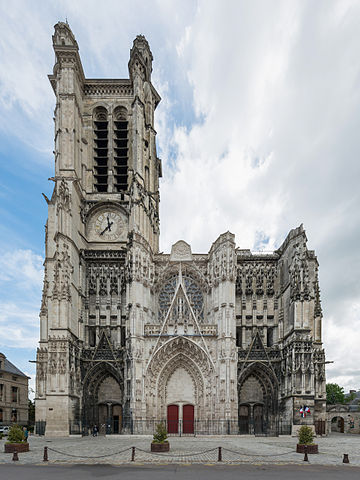The church in Lirey that ultimately housed the shroud was founded in 1353 by Charny.
On 20 June 1353, Geoffroy de Charny, Lord of Savoisy and Lirey, founded at Lirey a collegiate church with six canonries, in honour of the Annunciation of the Virgin Mary, and in this church he exposed for veneration a Holy Shroud.
https://en.wikipedia.org/wiki/Roman_Cat … _of_Troyes
It was a small wooden building and has long been destroyed.
“In the early 1350’s de Charny built a small, wooden church in tiny Lirey, where he was lord, to house various relics and, although not immediately documented, the Shroud.”
https://biblearchaeology.org/research/t … ttle-lirey
Lirey is a small town south of Troyes. It’s such a small town that even the population over the past decades has not been over 100 people.
https://en.wikipedia.org/wiki/Lirey
In contract to Lirey, Troyes was a major city. Troyes had been an important city in France and has a rich history.
The city has a rich historical past, from the Tricasses tribe to the liberation of the city on 25 August 1944 during the Second World War, including the Battle of the Catalaunian Plains, the Council of Troyes, the marriage of Henry V and Catherine of France, and the Champagne fairs to which merchants came from all over Christendom. The city has a rich architectural and urban heritage: many buildings are protected as historical monuments, including the half-timbered houses (mainly of the 16th century) that survived in the old town. They have contributed to Troyes being designated as a City of Art and History.Manufacturing of textiles, developed from the 18th century onwards, was a chief part of Troyes’ economy until the 1960s. Today, Troyes is the European capital of factory outlets and trading, and has three brand centers.
https://en.wikipedia.org/wiki/Troyes
It was so important, the troy weight was named after this city.
“During the Middle Ages, Troyes was an important international trading town. It was the namesake of troy weight for gold a standard of measurement developed here.”
https://en.wikipedia.org/wiki/Troyes
Troyes has many impressive cathedrals in it, with several dating to the Middle ages.

https://commons.wikimedia.org/wiki/File … 0509_1.jpg
The Cathedral of Troyes was started in the 12th century and completed in the 15th.
The Cathedral of Troyes is a fine Gothic structure begun in the 12th century, and completed in the 15th.
https://en.wikipedia.org/wiki/Roman_Cat … _of_Troyes
The Troyes cathedral also had housed relics.
Once the construction was underway, the Bishop departed on the Fourth Crusade in 1204, and brought back to Troyes a collection of precious relics for the cathedral treasury.The treasury of the cathedral was constructed at the beginning of the 13th century within the choir, next to the apse. It was particularly designed to display the collection of sacred relics which the Bishop Garnier de Traînel had brought back to France from the Fourth Crusade. Some of the relics and other valuable objects were used as ransom for the captive King Francois I in 1525, and others were lost during the Revolution, but the collection was gradually rebuilt. It has a particularly large collection of medieval enamel art, made by local craftsmen in the 12th century, as well as vestments, reliquaries and other medieval liturgical objects. Notable objects include the coffret of Troyes, an ivory chest of Byzantine craftsmanship from the 11th century.
https://en.wikipedia.org/wiki/Troyes_Cathedral

The Basilica of Saint Urban of Troyes was founded in 1262 and consecrated in 1389.
The Basilique Saint-Urbain de Troyes (Basilica of Saint Urban of Troyes), formerly the Église Saint-Urbain, is a massive medieval church in the city of Troyes, France. It was a collegial church, endowed in 1262 by Pope Urban IV.
https://en.wikipedia.org/wiki/Basilique … _de_Troyes
https://debatingchristianity.com/forum/viewtopic.php?p=1109508#p1109508
